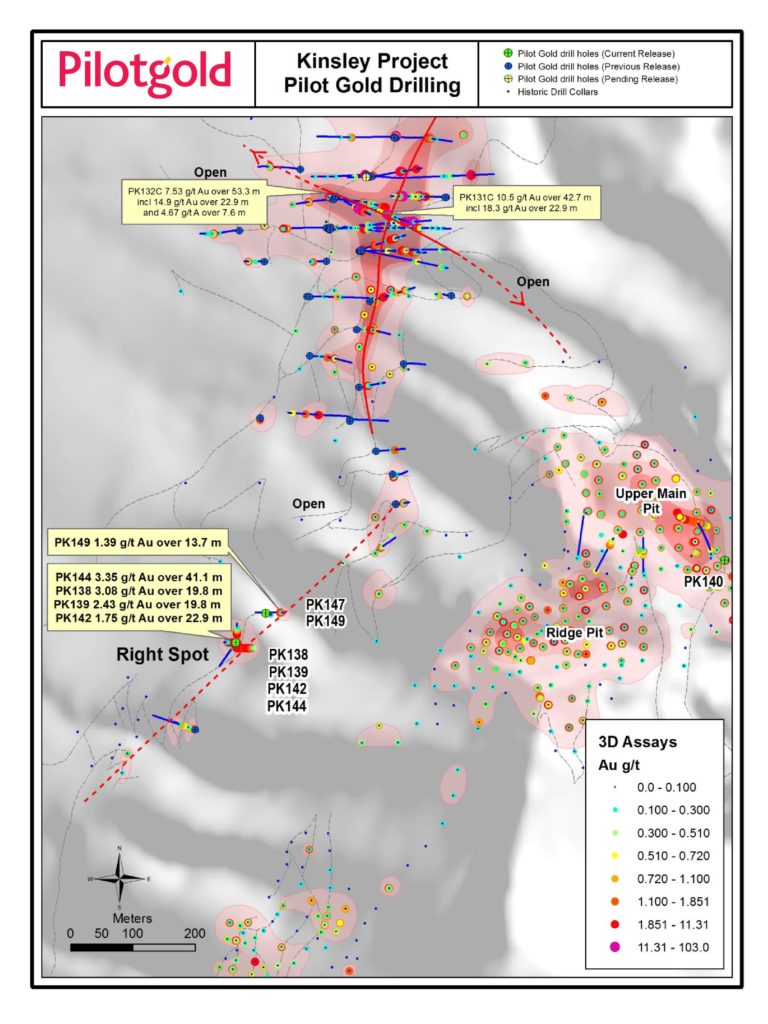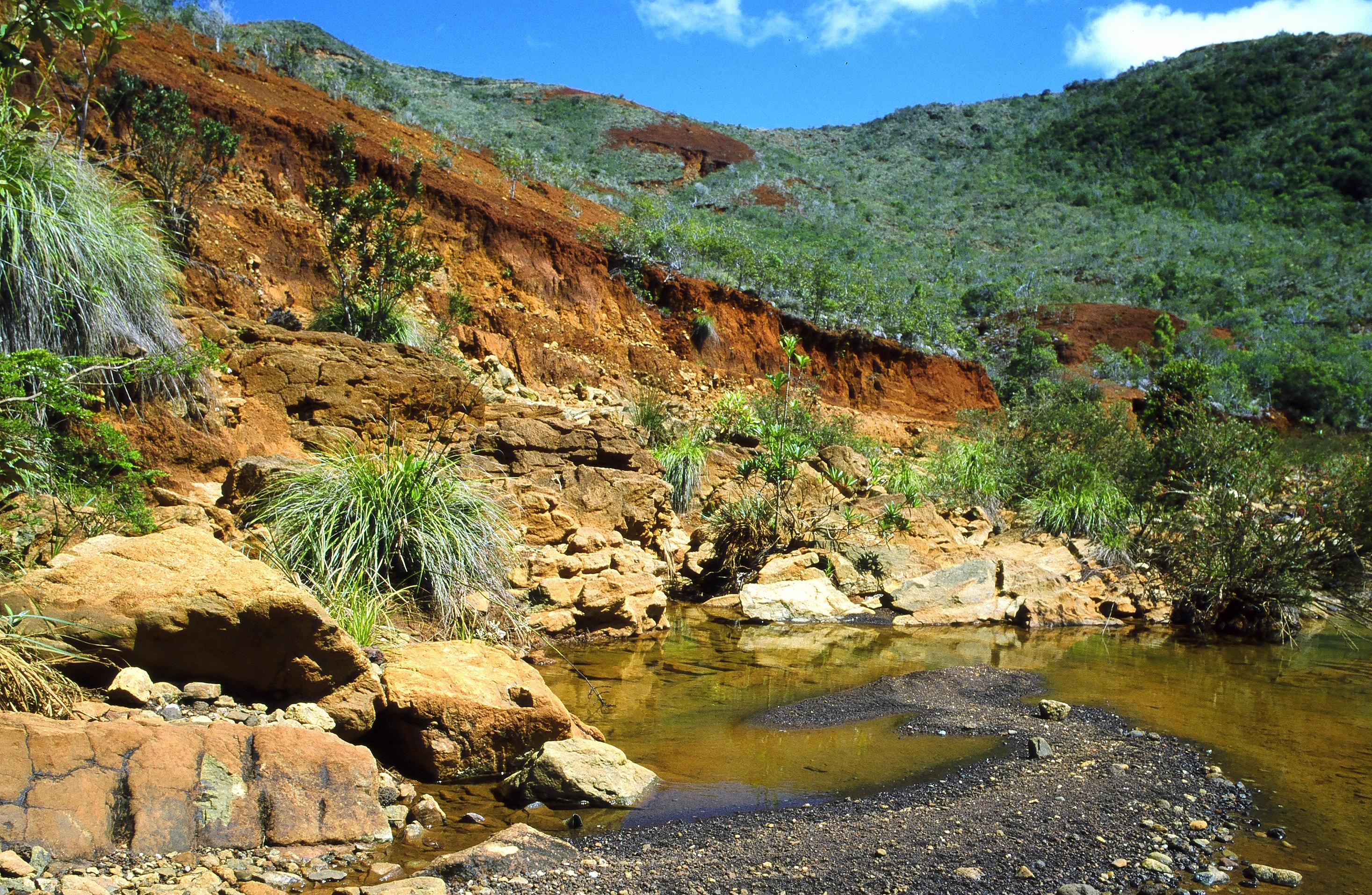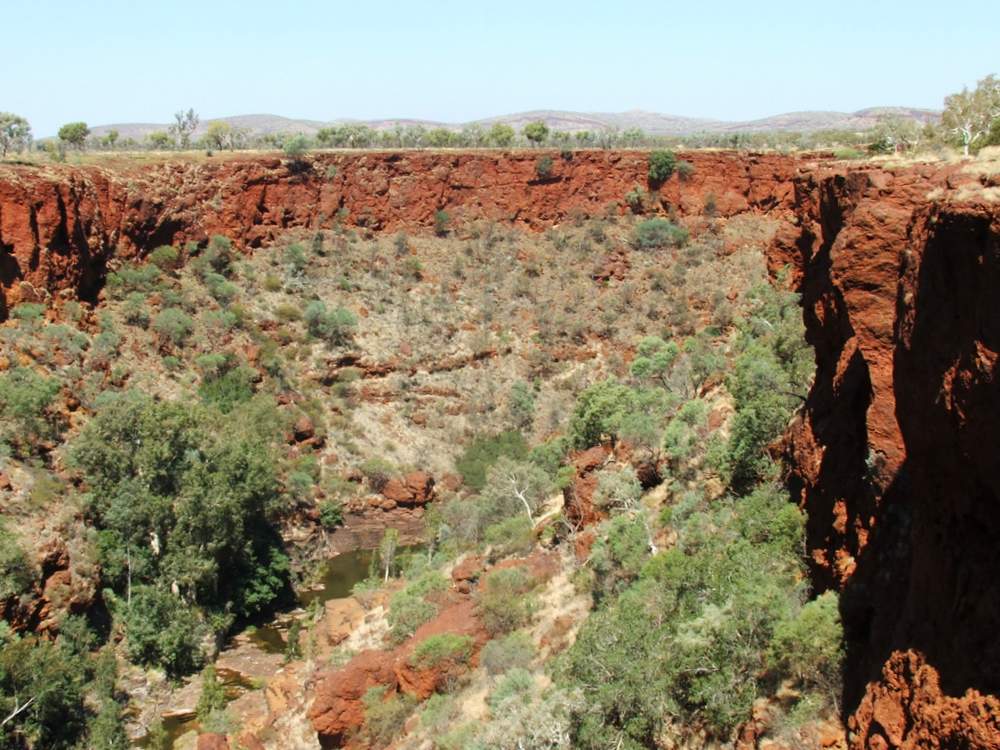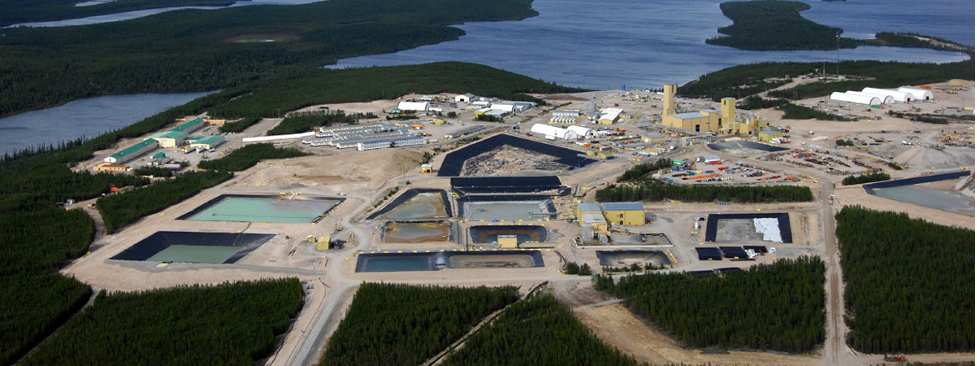Although the company is currently operating a large drill program and producing results, the uncertainty in the gold market is an over-powering market force.
[box type=”info” align=”aligncenter” ]Disclaimer: This is an editorial review of a public press release and not an endorsement. It may include opinions or points of view that may not be shared by the companies mentioned in the release. The editorial comments are highlighted so as to be easily separated from the release text and portions of the release not affecting this review may be deleted. [/box]
VANCOUVER, BRITISH COLUMBIA–(Marketwired – June 5, 2014) – Pilot Gold Inc. (TSX:PLG) (“Pilot Gold” or the “Company”) is pleased to announce that step-out drilling at Kinsley Mountain’s Right Spot target has returned long runs of predominantly oxide gold mineralization. The Right Spot target is located along the 2 kilometre-long NNE Western Flank trend, 1 kilometre south of the recently discovered high-grade zone.
Highlights from the Right Spot area include:
- 3.35 g/t (grams per tonne) gold over 41.1 metres in PK144, including
- 5.11 g/t gold over 4.6 metres;
- 3.08 g/t gold over 19.8 metres in PK138;
- 2.43 g/t gold over 19.8 metres in PK139;
- 1.75 g/t gold over 22.9 metres in PK142.
“We are at a tipping point in the evolution of Kinsley Mountain, with compelling near surface oxidized mineralization complementing the high grade Western Flank zone,” stated Matt Lennox-King, President and CEO of Pilot Gold.
[box type=”note” align=”aligncenter” ]Pilot Gold is a junior exploration company actively drilling on it’s Kinsley Mountain Property in Nevada, USA . As far as mining-friendly jurisdictions go, Nevada is among the best. It is politically stable, a proponent of the mining industry and world renowned for it’s carlin-type gold deposits. We’ve covered a few companies currently exploring within the state and have talked about Pilot’s Kinsley Project before.
Pilot Gold initiated a multi-phase 20,000 meter drill program in July 2013 and have continued to explore the property since then. We’ve included a copy of their drill results here.
The Kinsley Mountain Area has been actively mined and explored for silver, lead, copper and tungsten since the 1860’s, but it wasn’t until 1984 that gold was discovered in the area.[/box]
Right Spot Geology:
Mapping and rock sampling at the Right Spot identified a 250-metre northeast-trending zone of jasperoids returning 1-5 g/t gold in grab samples and 2.0 g/t gold over 15 metres in road cut samples. This zone of surface mineralization, hosted in the Candland Shale and Big Horse Limestone (the primary ore hosts at the historic Kinsley mine) extends under shallow cover to the northeast. Other stratigraphic host units, including the Clark Springs Limestone, Secret Canyon Shale and Hamburg Limestone, are modeled at depth.
[box type=”note” align=”aligncenter” ]
Carlin-type gold deposits formed when gold-bearing hydrothermal fluids permeated thick packages of sedimentary rocks during periods of large scale tectonic activity. The gold is precipitated throughout the rock as microscopic to near-invisible particles – which is why it took so long to discover the gold in this region. The gold is hosted in sedimentary limestone and shale within fine grains of iron and arsenic bearing sulfides (pyrite and arsenopyrite).[/box]
Drilling at Kinsley is ongoing with two RC and one diamond core rig. Targets currently being tested include extensions to high-grade mineralization in the Western Flank target area and an initial test of near-surface and deeper targets in the Secret Spot target area, located 1 km to the southwest of the Right Spot. Since inception of the summer drilling program, a total of 5,018 metres in four core and 13 RC holes has been drilled, with assays pending for 10 holes.
[box type=”note” align=”aligncenter” ]
Since the mineralization occurs near the surface and in fairly “soft” sedimentary rocks, the company is using RC drilling to quickly and cheaply drill. Although diamond drill core drilling can offer a higher degree of confidence in the interval grades and geological interpretation, it is significantly more expensive. RC programs are often augmented by planned diamond drilling to not only confirm the assay results from the RC program but also help determine the true orientation and thickness of the ore body.
[/box]
In late May 2014 Pilot Gold leased five patented claims (66 acres) located to the south of the historic Kinsley mine where prior operators intersected gold mineralization at and near surface within the Candland Shale. Pilot also conducted surface mapping and sampling to refine targets in the southern portion of the property.

Moira Smith, Ph.D., P.Geo., Chief Geologist, Pilot Gold, is the Company’s designated Qualified Person for this news release within the meaning of National Instrument 43-101 Standards of Disclosure for Mineral Projects (“NI 43-101”) and has reviewed and validated that the information contained in the release is accurate. Drill composites were calculated using a cut-off of 0.20 g/t. Drill intersections are reported as drilled thicknesses. True widths of the mineralized intervals are interpreted to be between 30-90% of the reported lengths. Drill samples were assayed by ALS Chemex (ISO9001:2000) in Reno, Nevada for gold by Fire Assay of a 30 gram (1 assay ton) charge with an AA finish, or if over 5.0 g/t were re-assayed and completed with a gravimetric finish. For these samples, the gravimetric data were utilized in calculating gold intersections. For any samples assaying over 0.200 ppm an addition cyanide leach analysis is done where the sample is treated with a 0.25% NACN solution and rolled for an hour. An aliquot of the final leach solution is then centrifuged and analyzed by AAS. QA/QC for all drill samples consists of the insertion and continual monitoring of numerous standards and blanks into the sample stream, and the collection of duplicate samples at random intervals within each batch. Selected holes are also analyzed for a 51 multi-element geochemical suite by ICP-MS.
[box type=”note” ]Since the company has given a somewhat detailed description of the assay and QA/QC procedures, we thought it a good opportunity to dig into the process ourselves.
Fire Assays’s and ICP-MS are two methods used by exploration companies to evaluate the amount of precious metals but also the chemistry of the rock. Fire assay’s are nothing new and have been performed for centuries. A fire assay involves the sample being pulverized to a fine powder and combined with a flux (material use to help capture precious metals). There are many different kinds of fluxes composed of silver, lead, carbon and their use depends on the type of analysis. This mixture of sample and flux is then heated to the point of melting where the flux acts as a collector and gathers the precious metals. The molten sample is then poured into a mould and cooled into a button (known as a prill) composed of silica and precious metals. The silica phase is hammered away and the precious metal bearing button is reheated in a crucible to remove the lead from the sample (known as cupellation). The remaining button is then dissolved in nitric acid leaving behind the gold from the original rock. If the remaining gold is large enough it can be weighed using a scale (known as a gravimetric finish). If the gold remaining is too fine to handle, then it is dissolved in hydrochloric acid and analyzed using a AA finish (Atomic Adsorption Spectroscopy).
ICP-MS or Inductively Coupled Plasma Mass Spectrometry is an analytical technique commonly used for determining the chemistry of a rock. Exploration geologists at times can draw conclusions on what makes a rock containing mineralization special compared to other rocks in the area. With this knowledge they can use it to target rocks with a similar chemistry.
[/box]
ABOUT KINSLEY MOUNTAIN
Kinsley Mountain hosts near-surface mineralization similar to other Carlin-style, sediment-hosted gold systems. The property consists of 460 claims and 8,720 acres (3,529 hectares) on U.S. Bureau of Land Management land and hosts a past-producing mine with an extensive exploration database and numerous, untested gold targets.
The Company holds approximately 79.1% of Kinsley. Intor Resources Corporation (“Intor”), a subsidiary of Nevada Sunrise Gold Corp., is the Company’s joint venture partner at Kinsley.
Kinsley Mountain is an early-stage exploration project and does not contain any mineral resource estimates as defined by NI 43-101. The potential quantities and grades disclosed herein are conceptual in nature and there has been insufficient exploration to define a mineral resource for the targets disclosed herein. It is uncertain if further exploration will result in these targets being delineated as a mineral resource.
Further information is available in the technical report entitled “Technical Report on the Kinsley Project, Elko County, Nevada, U.S.A.”, effective February 15, 2012 and dated March 26, 2012, prepared by Michael M. Gustin, CPG of Mine Development Associates and Moira Smith, Ph.D., P.Geo. and Kent Samuelson of Pilot Gold Inc., under Pilot Gold’s Issuer Profile on SEDAR (www.sedar.com).
[box type=”note” align=”aligncenter”]Pilot Gold’s stock had reached a 52 week high of $1.75 in March, 2014. As of writing, their stock has receded to $1.38. Like many exploration companies, their stock price has been under pressure from the massive gold sell-off that began in the middle of March. Gold prices have declined from $1380 per oz to $1240 per oz. or nearly 11% within a few months. Although the company is currently operating a large drill program and producing results, the uncertainty in the gold market is an over-powering market force.
As always we need to remind ourselves that this is an early stage exploration project. There are no NI43-101 compliant resources defined as of yet and further exploration will be required before they can do so. [/box]
ABOUT PILOT GOLD
Pilot Gold is a well-funded gold exploration company led by a proven technical team that continues to discover and define high-quality projects featuring strong grades, meaningful size and mining-friendly addresses. Our three key assets include interests in the Kinsley project in Nevada and the TV Tower and Halilaga projects in Turkey, each of which has the ability to become a foundational asset. We also have a pipeline of projects characterized by large land positions and district-wide potential that can meet our growth needs for years to come.
[box type=”success” align=”aligncenter” ]Have a company or release you’d like us to look at? Let us know though our contact page, through Google+, Twitter or Facebook.[/box]






